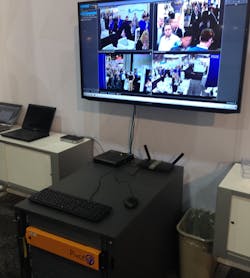As the worlds of IT and physical security have become more closely aligned with the continued migration from analog to IP, an ever increasing number of organizations have decided to shift the responsibility of purchasing and maintaining security devices onto their IT managers. In fact, a study released last year by Axis Communications found that 91 percent of organizations using video surveillance technology tasked their IT department to manage or support these deployments. Additionally, 47 percent of IT professionals polled reported that their department was the “most responsible” for setting surveillance strategy and making final purchasing decisions.
As would be expected from looking at statistics such as these, security systems integrators are now expected to speak the language of IT. One company that is looking to help integrators embrace this new paradigm is Pivot3. According to Brandon Reich, senior director of surveillance solutions at Pivot3, the company recently embarked on a new initiative focused on helping train and educate traditional security integrators in some of the more modern IT technologies, particularly around data storage, server virtualization and one of the new buzzword terms in the IT world that could have ramifications on the security industry in the years ahead which is the “software-defined” data center.
“The software-defined data center is taking many of the traditional, data center components – storage, servers, networking – and replacing the really big, complex, expensive, proprietary hardware solutions that have traditionally been used and replacing them effectively with software that performs the same functionality that is deployed now on really standard, off-the-shelf hardware. It does a couple of things: it allows companies to reduce costs, obviously, because these solutions traditionally cost a lot less but it also allows them to consolidate and break down barriers that they have between all of these servers, storage and networking functions,” explained Reich. “We feel our expertise, both in security and the IT world, provides the integrators, in particular, a pretty unique resource to help bring them up to speed and train, educate and help them understand what their customers are concerned about and what their big initiatives are.”
From a product perspective, Reich said one of the things that Pivot3 is highlighting at this year’s show is their Virtual Security Server, which virtualizes all of the client workstations dedicated to security and video surveillance applications within an organization.
“The benefit of that, for an end user, is the ability to significantly reduce costs involved with deploying a significant amount of really high-end, graphics intensive video workstations and to deliver a full functionality or full feature-rich desktop experience to a mobile device in a very secure and bandwidth-efficient fashion,” said Reich. “We’re really helping our end users to overcome some of the historic challenges that they’ve faced around data security, bandwidth utilization and limited functionality accessing that data remotely on a mobile device while helping them reduce their costs all at the same time.”
Within their traditional server and storage infrastructure solutions, Reich said they are continuing to increase their storage density to meet the changing demands of the marketplace. Among these new high-density solutions is a 96-terabyte storage server appliance, which can scale up to 1.2 petabytes in a single array, along with a new 128-terabyte storage appliance.
The company also recently inked a new partnership with Kom Networks, which makes a software solution required primarily for compliance purposes, such as in markets like law enforcement, where access to data is restricted to authorized personnel.
“All kind of new rules and stipulations are popping up and a lot of these have to do with secure retention of video surveillance data generated by body-worn cameras. Our partnership with Kom Networks will help our users better comply with some of these regulations and requirements coming up where retention times can go upwards of five years in some cases.,” said Reich. “In fact, we’ve had one customer, a law enforcement agency out of New Jersey, which has a requirement to store evidentiary video for as long as 99 years. Our integration with Kom Networks will help them do that.”
Although video storage has almost become an afterthought for many people given how prices for storage have fallen, Reich said he expects storage demand will only grow exponentially in the years ahead and Pivot3 is well-positioned to meet those increased storage needs as they arise.
“The demand for storage is growing at an unbelievably fast rate. Not only are end users using video for traditional uses to catch bad guys and deter crime but for other purposes as well,” said Reich. “They are using it to protect themselves against liability as with the use of body-worn cameras, they’re using it in loss prevention applications where they leverage analytics or other types of technologies in conjunction with video to prevent incidents from happening in advance and they’re using it for situation management and response. One of the things that we, as an industry, haven’t always understood is video surveillance is very different from other traditional types of IT data that are out there. We get one chance to store video when it comes in and if we don’t do it, if our systems can’t keep up and we don’t properly process and store the data, it’s just gone, it’s just lost. That means these super high-quality, high-resolution images that we’ve paid hundreds of thousands, if not millions of dollars to produce, become degraded.”




